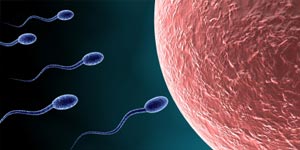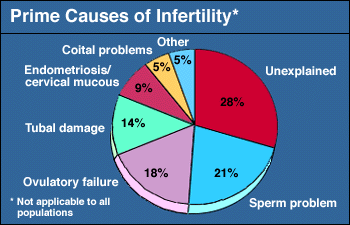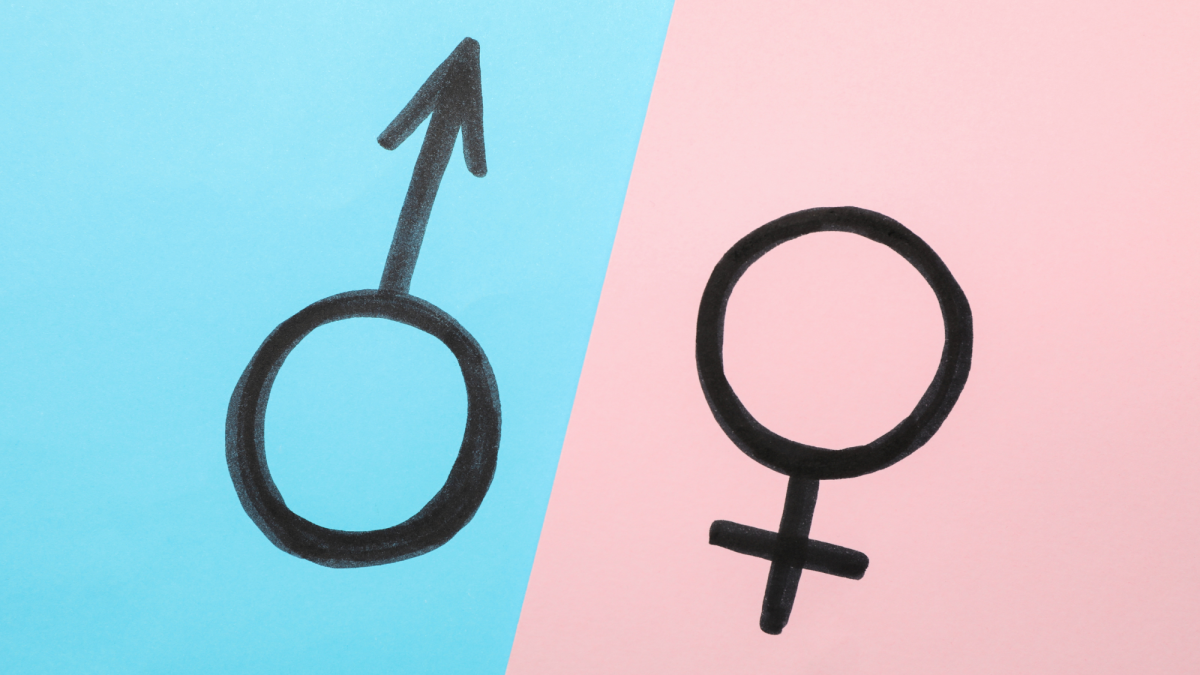Male and Female Infertility and Assisted Reproductive Technologies

Infertility is the biological inability for person of either sex to reproduce due to a defect in gametes or a reproductive tract [2] [4].
The incidence of infertility is estimated to affect approximately 9% of females in the world both developed and non-developed nations, with an estimate that one in four couples may be infertile. In 40% of cases, the problem rests with males, 40% lies with females, 10% to both partners and 10% to unknown causes[5].
Most causes of male infertility are a result of chromosomal/genetic issues[1] or as a result of environmental/lifestyle factors and injury[2]. These include sperm production problems[2], blockage of sperm transport [4], sperm immunology[5], varicocele infections[1], and pituitary tumours[1].
Most causes of female infertility are a result of lifestyle factors, hormonal changes and physical defects from injury/birth[2]. Causes of female infertility include polycystic ovarian syndrome (PCOS) [2], Primary ovarian insufficiency (POI)[5], blocked fallopian [4], uterus/cervical disorders [2], and endometriosis [5].
What these causes of infertility in both sexes share is the interruption of reproduction, being the joining of both male and female gametes. Through disrupting intercourse, hindering fertilization, or not interfering with a necessary component, pregnancy is unable to occur. For example, sperm immunology can cause produced sperm to be destroyed, disabling the ability for both gametes to fuse. Alternately, it may reduce their movement or ovum binding ability, once again inhibiting fertilization by not allowing it to occur. Other causes like endometriosis and PCOS do not allow for ovulation to occur and as an extension, fertilization.

Treatments for infertility
To counteract infertility, there are many treatments available, or Assisted Reproductive Technologies (ART's). The interrelationships between infertility and ART's centre around the circumvention of these causes of infertility, bypassing certain processes and allowing for reproduction and pregnancy to occur, such as providing alternatives to insemination or fertilization.
Three ART's include in vitro fertilisation (IVF), zygote intrafallopian transfer (ZIFT) and Intracytoplasmic sperm injection (ICSI).[5]
In IVF, ZIFT and ICSI, the gametes of both sexes are collected the same way. The female gametes are harvested through the process of ovarian hyperstimulation, whereby downregulation of the pituitary ovarian axis is made through prolonged use of a GnRH agonist. An administration of FSH stimulates multiple ovum growth and the resulting ova are harvested[2][5]. Male gametes are collected via masturbation if possible, otherwise local anaesthesia is applied and, via needle or incision, sperm is extracted from a testis[6].
IVF is a treatment used when fallopian tubes are blocked[5] as fertilization occurs in the fallopian tubes. This process may be interrupted by scarring or other causations of blockages, causing infertility. Once both sexes' gametes have been harvested, the ovum is transferred into a Petri dish with the sperm and fertilisation occurs in laboratory where the zygote grows for ~3 days before being placed into the uterus where regular pregnancy occurs[2]. IVF has an average live birth success rate of 27%[5].
ZIFT is almost identical to IVF, although is used to treat a defect with sperm/sperm production. Differing from IVF, ZIFT is used because produced sperm may be low and/or more defunct which would cause infertility. This technology selects healthy sperm for fertilization. The harvested gametes are introduced in a laboratory like IVF, however the resulting zygote is not left to grow before transportation, and is instead transferred to the fallopian tubes rather than uterus where pregnancy occurs regularly[5]. ZIFT has a 64.8% success rate.
ICSI is a treatment used when there are issues with sperm/sperm production and used for older couples and when IVF fails[2]. As with ZIFT, this technology is used because produced sperm is low or contains defects which would stop fertilization under normal circumstances. A single harvested sperm is injected to a harvested oocyte and the resulting zygote may be immediately placed into fallopian tubes or left to grow in laboratory for ~3 days and then placed in uterus[5]. ICSI has an average success rate of 24%[7].
Has infertility ever affected you?
Problems associated with infertility
The problems associated with ART's include procedural and ethical issues.
Procedural issues surround the risks of ART on the children and mother. Genetic infertility factors passed from parent to child through use of ART, high likelihood of multiple pregnancies increasing mortality rate for the child(ren) and mother, infection during gamete collection and hormone side-effects are examples[5].
Ethical issues of ART's include posthumous use of gametes, surrogacy, donor conception, sex selection, pre-implantation genetic diagnosis (PGD) and age limits of ART's[3]. These ethical issues mainly revolve around the perceived wellbeing of the child/embryo.
For example, the use of ART's on older couples is a debated topic on whether it follows the rights of a person or violates the rights of a child. Studies show that while it is in the rights of a person to seek ART's to reproduce at older ages, it is incompetent[8], bringing many negatives. This practice/technology should not be allowed for many reasons, including the fact that there are higher risks of child defects using gametes from older persons[5] and, on average, insufficient childcare mentally, physically and financially by older couples[8].
In addition, surrogacy is a controversial and publicised issue for twofold reasons. Firstly, the use of another woman to carry the zygote of another couple is claimed to increase the chance of birth defects[9]. The other reason is that it allows same-sex couples the ability to reproduce somewhat normally, which is deemed to cause the previously stated issue along with decreasing the child's quality of life from not having a parent of both sexes/genders[9][10]. Unlike advanced age parenthood, this practice/technology should be allowed as many studies have shown that children and parents of surrogacy have no additional genetic nor physiological concerns than regular parents[9], and in addition, children of same-sex couples demonstrate no negative effects from having same-sex parents[10] with evidence showing that children with homosexual parents preform equally to those with heterosexual parents and experience no additional psychological issues as a result[10].
ART's likely to expand in the future include extrauterine fetal incubation (EUFI) and as an extension, artificial uterus. EUFI would effectively negate the natural uterus and act as a replacement organ for damaged/diseased uteri when bringing the fetus to term. Having seen success in the shark population[11], EUFI and artificial uterus may eventually be possible treatments to human infertility. These ART's however may increase the current ethical issues associated with ART's along with raising new ones, such as a growing reliance and usage of the technologies. In addition, when coupled with another future ART, parthenogenesis, the exploitation of the technologies to create 'perfect' children or bypass regular reproduction may extend beyond the original purpose to help couples conceive when circumstances prevented them from doing so.
have you ever had treatment for infertility?
References and bibliography
-
Professor Robert McLachlan, Male Infertility [document on the internet], Andrology Australia; 2012 May 30 [cited 2013 July 27]. Available from: <https://www.andrologyaustralia.org/reprod uctive-problems/male-infertility/>
-
Office on Women's Health U.S. Department of Health, Infertility Fact Sheet [document on the internet], Women's Health; 2009 July 1 [cited 2013 July 27]. Available from <http://www.womens health.gov/publications/our-publications/fact-sheet/infertility.cfm>
-
National Health and Medical Research Council, Assisted Reproductive Technology (ART) [document on the internet], Australian Government; 2013 May 1 [cited 2013 July 28]. Available from <http://www.nhmrc.gov.au/health-ethics/australian-health-ethics-committ ee-ahec/assisted-re productive-technology-art/assisted>
-
Huxley, L. M. (Lorraine M.). Biology: An Australian Perspective. 2nd ed. Oxford; 2011.
-
Shae-Lee McArthur, Infertility [document on the internet], ABC Health and Wellbeing; 2013 [cited 2013 August 7]. Available from <http://www.abc.net.au/health/library/stories/2007/05/3 0/1919840.htm#.UgOB7207akM>
-
Sperm Retrieval Procedures [document on the internet], Johns Hopkins Medicine - The James Buchanan Brady Urological Institute; n.d. [cited 2013 August 7]. Available from: <http://maleferti lity.jhu.edu/SpermRetrieval.php>
-
Fertility Treatment: Intracytoplasmic Sperm Injection (ICSI) [document on the internet], BabyCentre Medical Advisory Board; 2013 May [cited 2013 August 8]. Available from: <http://www.babycentre.co.uk/a4097/fertility-treatment-intracytopla smic-sperm-injection-icsi#se ction5>
-
David Banh, Dara Havemann, John Phelps, Reproduction beyond Menopause: How old is too old for assisted reproductive technology? [document on the internet], Department of Obstetrics & Gynecology; 2010 May 8 [cited 2013 August 8]. Available from: <http://www.ncbi.nlm.nih.gov/p mc/articles/PMC2922699/>
-
Susan Golombok, Jennifer Readings, Lucy Blake, Polly Casey, Alex Marks, Vasanti Jadva, Families created through surrogacy: Mother-Child relationships and children's psychological adjustment at age 7 [Peer Reviewed Journal on the internet], American Psychological Association; 2012 [cited 2013 August 10]. Available from: <http://psycnet.apa.org/?&fa=main.doi Landing&doi=10.1037/a0025292>
-
Ellen Perrin, Benjamin Siegel, Promoting the Well-Being of Children Whose Parents are Gay or Lesbian [document on the internet], American Academy of Pediatrics; 2013 March 20 [cited 2013 August 10]. Available from: <http://pediatrics.aappublications.org/content/early/2013/03/18/ped s.2013-0377>
-
Danielle Venton, Baby Sharks Birthed in Artificial Uterus [document on the internet], Wired; 2011 September 9 [cited 2013 August 22]. Available from <http://www.wired.com/wiredscience/2 011/09/artificial-shark-uterus/>








